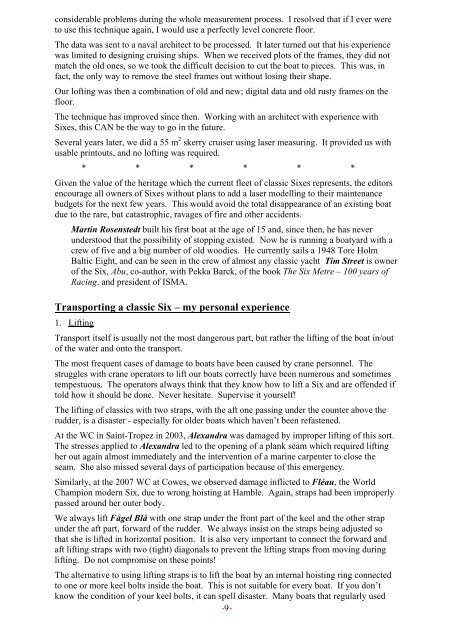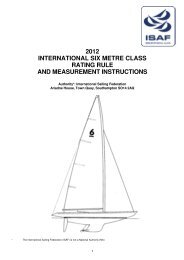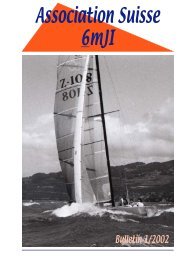CLASSIC SIX METRE NEWSLETTER
CLASSIC SIX METRE NEWSLETTER
CLASSIC SIX METRE NEWSLETTER
You also want an ePaper? Increase the reach of your titles
YUMPU automatically turns print PDFs into web optimized ePapers that Google loves.
considerable problems during the whole measurement process. I resolved that if I ever were<br />
to use this technique again, I would use a perfectly level concrete floor.<br />
The data was sent to a naval architect to be processed. It later turned out that his experience<br />
was limited to designing cruising ships. When we received plots of the frames, they did not<br />
match the old ones, so we took the difficult decision to cut the boat to pieces. This was, in<br />
fact, the only way to remove the steel frames out without losing their shape.<br />
Our lofting was then a combination of old and new; digital data and old rusty frames on the<br />
floor.<br />
The technique has improved since then. Working with an architect with experience with<br />
Sixes, this CAN be the way to go in the future.<br />
Several years later, we did a 55 m 2 skerry cruiser using laser measuring. It provided us with<br />
usable printouts, and no lofting was required.<br />
* * * * * *<br />
Given the value of the heritage which the current fleet of classic Sixes represents, the editors<br />
encourage all owners of Sixes without plans to add a laser modelling to their maintenance<br />
budgets for the next few years. This would avoid the total disappearance of an existing boat<br />
due to the rare, but catastrophic, ravages of fire and other accidents.<br />
Martin Rosenstedt built his first boat at the age of 15 and, since then, he has never<br />
understood that the possibility of stopping existed. Now he is running a boatyard with a<br />
crew of five and a big number of old woodies. He currently sails a 1948 Tore Holm<br />
Baltic Eight, and can be seen in the crew of almost any classic yacht Tim Street is owner<br />
of the Six, Abu, co-author, with Pekka Barck, of the book The Six Metre – 100 years of<br />
Racing. and president of ISMA.<br />
Transporting a classic Six – my personal experience<br />
1. Lifting<br />
Transport itself is usually not the most dangerous part, but rather the lifting of the boat in/out<br />
of the water and onto the transport.<br />
The most frequent cases of damage to boats have been caused by crane personnel. The<br />
struggles with crane operators to lift our boats correctly have been numerous and sometimes<br />
tempestuous. The operators always think that they know how to lift a Six and are offended if<br />
told how it should be done. Never hesitate. Supervise it yourself!<br />
The lifting of classics with two straps, with the aft one passing under the counter above the<br />
rudder, is a disaster - especially for older boats which haven’t been refastened.<br />
At the WC in Saint-Tropez in 2003, Alexandra was damaged by improper lifting of this sort.<br />
The stresses applied to Alexandra led to the opening of a plank seam which required lifting<br />
her out again almost immediately and the intervention of a marine carpenter to close the<br />
seam. She also missed several days of participation because of this emergency.<br />
Similarly, at the 2007 WC at Cowes, we observed damage inflicted to Fléau, the World<br />
Champion modern Six, due to wrong hoisting at Hamble. Again, straps had been improperly<br />
passed around her outer body.<br />
We always lift Fågel Blå with one strap under the front part of the keel and the other strap<br />
under the aft part, forward of the rudder. We always insist on the straps being adjusted so<br />
that she is lifted in horizontal position. It is also very important to connect the forward and<br />
aft lifting straps with two (tight) diagonals to prevent the lifting straps from moving during<br />
lifting. Do not compromise on these points!<br />
The alternative to using lifting straps is to lift the boat by an internal hoisting ring connected<br />
to one or more keel bolts inside the boat. This is not suitable for every boat. If you don’t<br />
know the condition of your keel bolts, it can spell disaster. Many boats that regularly used<br />
- 9-
















